Captive rearing of fish seed as a livelihood opportunity in flood prone areas
Captive rearing of fish seed as a livelihood opportunity in flood prone areas
Climate vulnerability
Floods, Cyclone
Existing practice
Availability of quality stock size fingerlings of freshwater fish species for stocking in tanks has been a limiting factor for fish production in the panchayat/ community tanks. Fisher folks face difficulty in procurement of quality fingerlings in required numbers which have to be transported over long distances which often results in poor survival besides increasing the cost of fingerlings. Changes in rainfall pattern cause uncertainty in releasing fish seed on time into community tanks and sometimes results in loss of stocked fish seed due to floods.
Resilient practice/ technology
Captive rearing of fish seed i.e. rearing of early stages (spawn to fry and fry to fingerling stages) through appropriate feed and health management in nursery pond was demonstrated in Sirusuwada village, Kothur mandal of Srikakulam district, Andhra Pradesh. Required training for captive rearing was provided to the fisher folk by the KVK.
Impact
Sri Chekka Sanyasi and three other fishermen of Sirusuvada (NICRA village) practiced fresh water fish culture with Indian Major Carps in Jagannath Naidu tank spread over an area of 25 acres during August- September and about 8 acres water spread during February-March. Earlier these farmers used to stock the tank with fish seed at fry stage of 2-3 cm size brought from the local fish seed farm which resulted in poor survival and inappropriate stocking ratios. Cost of fingerling of size 6-8 cm was high (Rs 1.5 to 3.0). During 2013-14, few farmers were identified and trained in nursery rearing of fish seed at fry stage in nursery pond. They were supported with fish seed at fry stage and the feed material. About 25000 numbers of fish seed at fry stage were released on 8th August, 2013 in 25 x 25 m2 nursery pond. Rearing to fingerling size was done for 29 days and harvested on 6th September to release into the village tank. The main learning for the fishermen was on acclimatization of fish seed before stocking and feed made up of rice bran and groundnut cake (1:1 ratio) and on regular sampling for monitoring the growth and health of fish seed. By this technology farmers saved about Rs 10500 on cost of fish seed. This attracted other farmers to adopt the technology in the village.
Economics of captive rearing of fish seed
| Particulars | Cost (Rs) |
|---|---|
| Cost of fish seed (25000 No's) | 9500 |
| Feed cost | 1500 |
| Labour charges | 1000 |
| A) Total cost for captive rearing per month | 12000 |
| B) Cost of fingerling at market price @ Rs1.50 for 15000* fingerlings | 22500 |
| Net saving (B-A) (Rs/unit) | 10500 |
* Calculated based on survival of fish seed to fingerling size in nursery pond estimated @ 60%
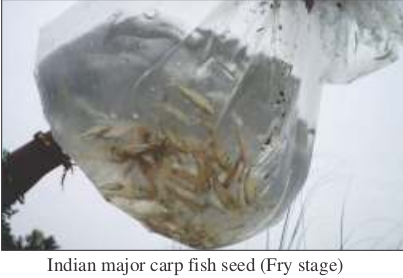
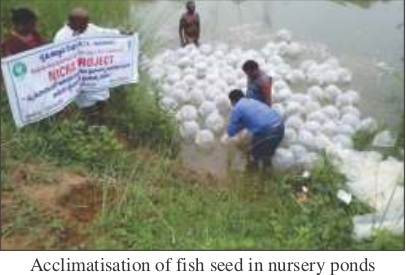
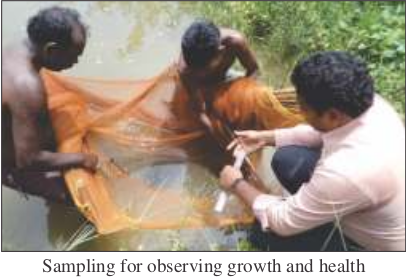
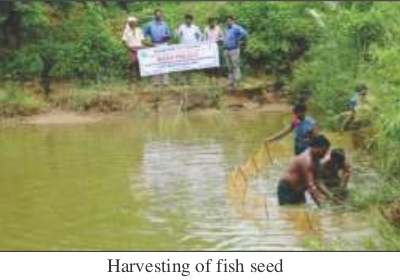
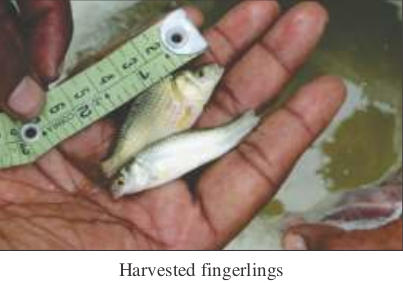
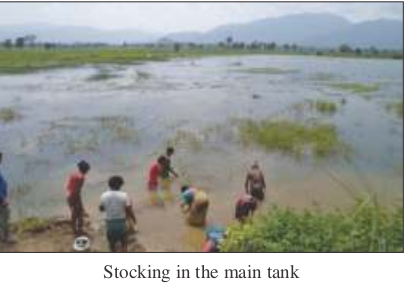
Source: Smart Practices and Technologies for Climate Resilient Agriculture
Last Modified : 2/12/2020
This topic provides information about Community ta...
This topic provides information about Check dams f...
This topic provides information about Crop diversi...
This topic provides information about Drought tole...
